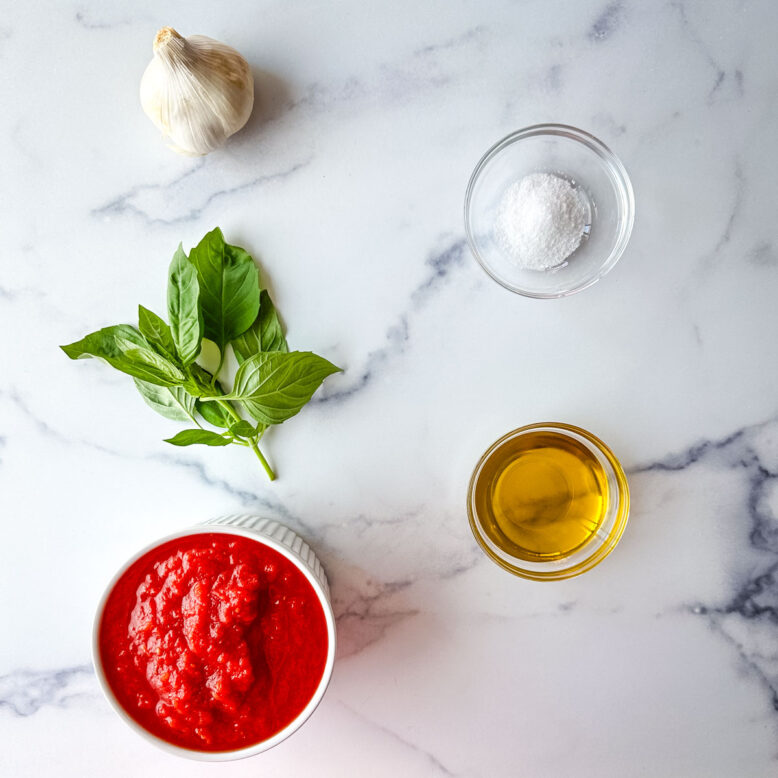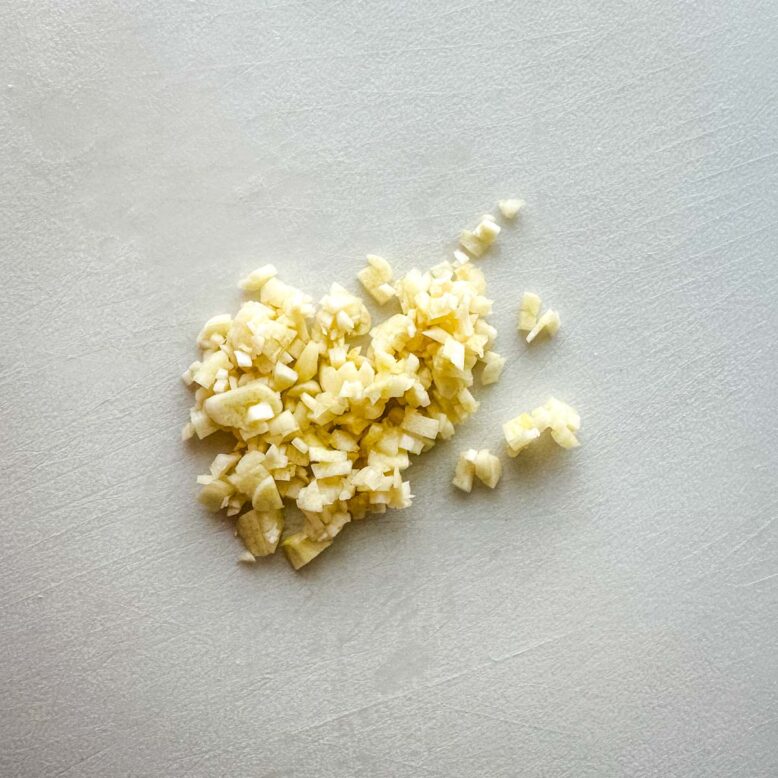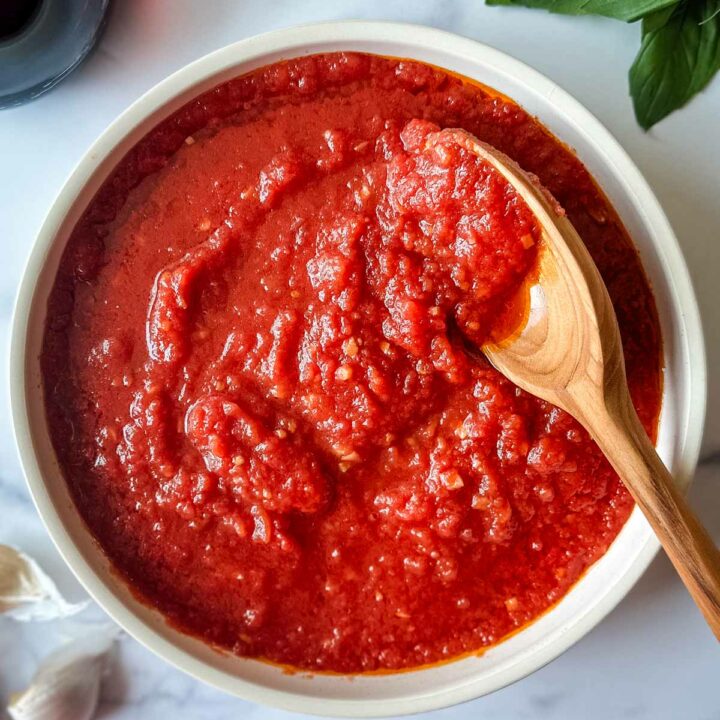This traditional homemade marinara sauce is a delicious, savoury condiment perfect for pasta! With San Marzano tomatoes, bold garlic, rich olive oil, and fresh basil, this is the best marinara sauce you’ve ever tasted.

Why You’ll Love This Authentic Italian Marinara Sauce
You’ll love this recipe because it is an easy-to-make tomato sauce made with simple ingredients. The rich olive oil, savory garlic, bright tomatoes, and fresh basil come together to create a wonderfully flavorful, balanced sauce. With just a bit of time and minimal preparation, it’s much better than jarred marinara!
Traditional Marinara Sauce Ingredients

Canned Tomatoes: You can use crushed tomatoes or whole peeled tomatoes that you crush by hand.
Basil: This recipe calls for fresh basil. I would not substitute this for dried basil, as the flavor will not be as prominent or traditional.
Garlic: Fresh peeled and chopped garlic is the best option for this sauce.
Olive Oil: If you have good-quality extra virgin olive oil on hand, I recommend using that. However, any type of olive oil will work to create a delicious marinara.
Pasta (Optional): If you are serving this marinara sauce over pasta, choose whichever shape appeals to you most, whether that is a long, thin shape like spaghetti or a small, tubular shape like penne.
How to Make Marinara Sauce from Scratch
1. Finely chop your garlic.
1. Trita finemente l’aglio.

2. Place a medium to large sauce pot over medium heat. Add the olive oil. Once the olive oil is shimmering, add the garlic and cook until just fragrant, 30 seconds to 1 minute.
2. In una pentola di dimensioni medie o grandi, metti a scaldare l’olio d’oliva a fuoco medio. Una volta che l’olio d’oliva inizia formare delle bollicine, aggiungi l’aglio e cuoci fino a quando senti un profumo delicato, da 30 secondi a 1 minuto.

3. Add the crushed tomatoes to the pot with the salt and fresh basil. Bring the sauce up to a low boil and down to a simmer. Let the sauce simmer for 25 to 30 minutes.
3. Aggiungi i pomodori schiacciati nella pentola con il sale e il basilico fresco. Porta la salsa ad un leggero bollore e poi abbassa la fiamma. Lascia cuocere la salsa per 25-30 minuti.

4. Remove the sprig of basil.
4. Rimuovi il basilico.

5. Taste for seasoning and serve.
5. Assaggia per controllare il condimento e poi servi.

Storage and Reheating
Fridge: Store leftover marinara sauce in an airtight container in the fridge for 3 to 4 days.
Freezer: After your sauce has cooled, transfer it to a freezer-safe airtight container and freeze for up to 6 months.
Reheating from Fridge: To reheat, add your sauce to a pot over medium heat. Bring up to a boil and down to a simmer before serving.
Reheating from Frozen: Defrost the sauce in the refrigerator overnight. Add to a pot over medium heat, bring up to a boil and down to a simmer before serving.
History of Marinara Sauce
The word “marinara” translates to “seafaring,” which is understood by food historians to mean “sailor-style” or “mariner-style.” It is believed that marinara was given this name because it was originally a sauce with seafood beloved by Italian merchants during voyages at sea.
Marinara sauce was likely created first in southern Italy, in Sicily or Naples. However, the location and time of creation are not well-documented. Tomatoes arrived in Europe in the 16th century, so historians believe that this is the approximate time that the sauce was developed.
The first mention of tomato sauce in an Italian cookbook was by the Italian chef Antonio Lantini in 1692, and the first recipe for pasta with tomato sauce appears in a cookbook by Francesco Leonardi in 1790.
Variations
Popular variations of marinara sauce include:
Onion: You can chop an onion and sweat it prior to adding the garlic if you’d like to try this variation.
Oregano: Some people enjoy adding a bit of oregano to the sauce for an extra bit of earthy, floral flavor.
Fresh Tomatoes: You can use fresh tomatoes in place of canned tomatoes for this preparation. If using fresh tomatoes, I recommend blanching and peeling them prior to adding them to the sauce.
Tomato Paste: For an extra rich, full-bodied sauce, add tomato paste after the garlic has cooked. Let it cook down for a minute or two before adding the remaining ingredients.
Red Pepper Flakes: Adding red pepper flakes to your sauce can add just a hint of heat and wake up the flavor of your dish.
FAQ
What is the difference between marinara vs pizza sauce?
Marinara sauce tends to be a cooked sauce, while pizza sauce is typically uncooked.
What is the difference between marinara vs bolognese?
Marinara is a fresh, vegetarian sauce while bolognese is a long-cooked meat sauce.
What is the difference between ragù vs marinara?
Ragù is also a meat-based sauce, traditionally cooked over low heat in a braising liquid for a longer period of time than the quick-cooking marinara sauce.
Uses for this Classic Marinara Sauce Recipe
Use this marinara recipe for…
Spaghetti Sauce: Serve with your favorite pasta for an easy and delicious dinner!
Lasagna: Use this easy homemade marinara sauce as a part of your favorite lasagna.
Dipping Sauce: This marinara sauce is a flavorful condiment or dipping sauce for bread and mozzarella sticks.
Expert Tips
Use San Marzano tomatoes. I recommend using San Marzano tomatoes, as they have a superior flavour to other types of tomatoes. They are sweet and have lower water content and fewer seeds than other types of tomatoes.
Scale this recipe for a bigger crowd. This recipe makes approximately 3 cups of sauce. You can double or even triple the recipe for a larger group.
Try using different consistencies. If you prefer a chunkier sauce, you can try adding diced tomatoes to the sauce. If you prefer a smoother sauce, you can pass everything through a blender for an extremely smooth consistency. Experiment to see what you like best!

Homemade Marinara Sauce
This homemade marinara sauce is easy to make with just 5 simple ingredients including tomatoes, olive oil, and garlic for a perfect pasta sauce.
Ingredients
- 2 Tbsp extra virgin olive oil
- 4 cloves garlic, finely chopped
- (1) 28-ounce can of San Marzano tomatoes,
- crushed or whole-peeled
- 1 sprig fresh basil
- Salt to taste
Instructions
- Finely chop your garlic.
- If using whole peeled tomatoes, place the tomatoes in a bowl and use your hand to gently crush the tomatoes.
- Place a medium to large saucepot over medium heat. Add the olive oil. Once the olive oil is shimmering, add the garlic and cook until just fragrant, 30 seconds to 1 minute.
- Add the tomatoes to the pot with the salt and fresh basil. Bring the sauce up to a low boil and down to a simmer. Let the sauce simmer for 25 to 30 minutes.
- Remove the sprig of basil.
- Taste for seasoning and serve.
.
Notes
- Store leftover marinara sauce in an airtight container in the fridge for 3 to 4 days.
- To freeze, after your sauce has cooled, transfer it to a freezer-safe airtight container and freeze for up to 6 months.
- To reheat from the fridge, add your sauce to a pot over medium heat. Bring up to a boil and down to a simmer before serving.
- To reheat from frozen, defrost the sauce in the refrigerator overnight. Add to a pot over medium heat, bring up to a boil, and down to a simmer before serving.
.
Nutrition Information:
Amount Per Serving: Calories: 274Total Fat: 28gSaturated Fat: 4gUnsaturated Fat: 3gSodium: 40mgCarbohydrates: 6gFiber: 1gSugar: 1gProtein: 1g

Genevieve La Rocca is a professional chef, lifelong recipe creator, writer, and editor. As a native Californian and a major food lover, she is constantly developing new dishes, many of which are inspired by her Italian roots.


